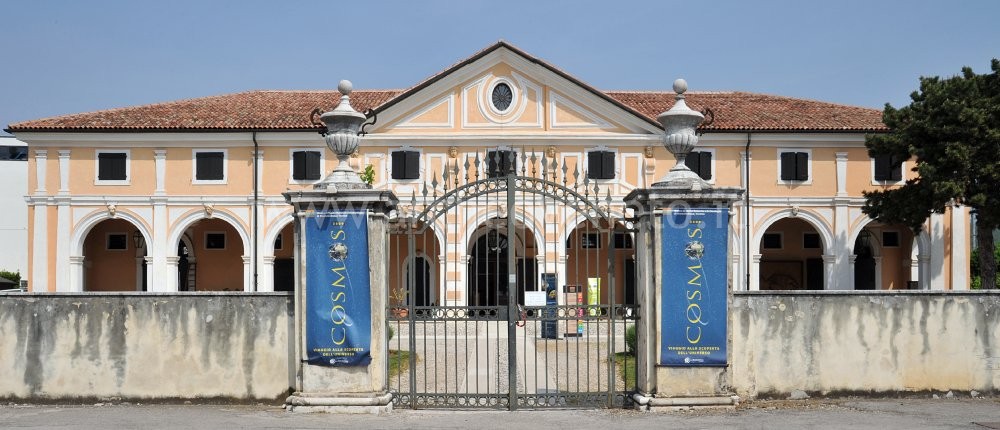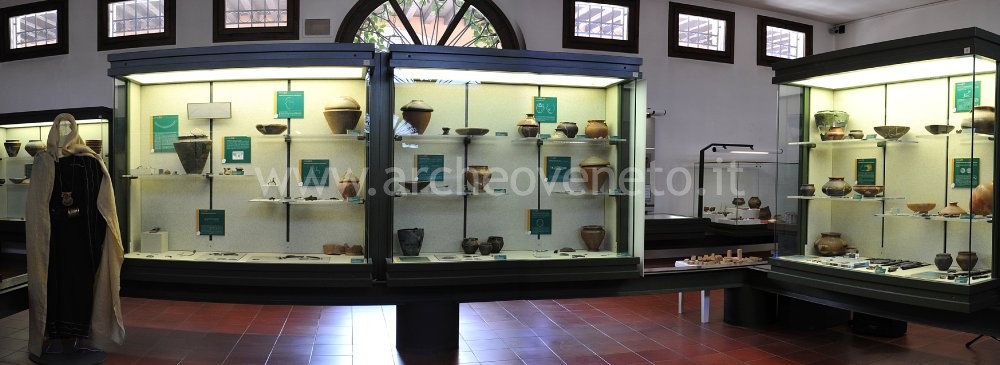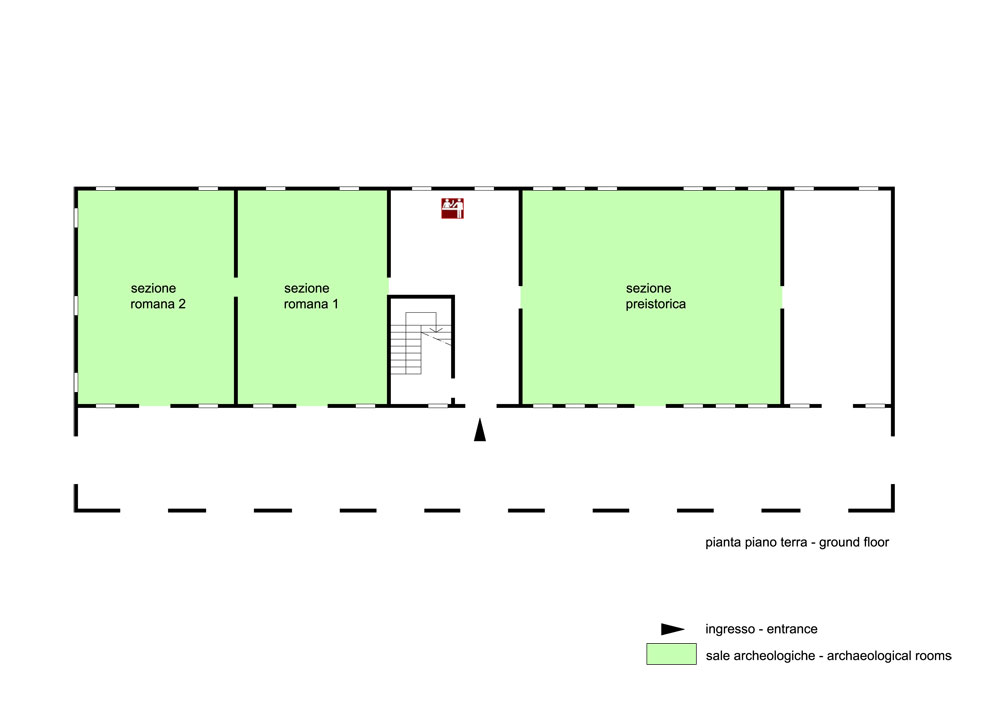|
|
File
Natural History and Archaeology Museum – Montebelluna
|
Via Piave 51 (Villa Biagi) – 31044 Montebelluna (TV)
– Fax 0423 602284 |
  |
|
Summary

The Civic Museum of Montebelluna is closely linked to its land, since through the collection, the exhibition and the analysis of the finds displayed, it studies and disseminates the historical-archaeological memory of this area. The museum is divided into two parts: the naturalistic section and the archaeological one. The archaeological collection consists of the finds discovered thanks to the field walking technique and the excavations that have been carried out over the years in Montebelluna and its surroundings. Beside the permanent exhibition, the Museum is provided with an archive, a study room, conference halls, storage areas and numerous didactic workshops.
Collection history
The Civic Museum was established in 1984 in the wonderful Villa Biagi, thanks to the initiative of a local speleological group and the municipality. The collections displayed are the result of donations made by private citizens or of recent excavation and field walking activities carried out by the regional board for the protection of the cultural heritage in the area around Montebelluna.
|

 The exhibition starts from the very first stages of human evolution, which are presented thanks to the chronological seriation of the skulls of the first hominids and of their tools. Then the visit goes on showing the materials dating back to a subsequent phase of pre-history, that is Neolithic. It is possible to see examples of vases belonging to the culture of the Square Mouth Vases (first half of the 4th millennium B.C.) and to the one influenced by the tradition of the Sub-Apennines and of Chassey-Lagozza, which were found in the archaeological site of Valle San Lorenzo in Cornuda. A large amount of stone materials and numerous remains of animal bones were discovered in this area. The same display case contains other prehistoric finds discovered in the area surrounding Montebelluna, such as numerous examples of lithic industry of the late Neolithic-early Copper Age and other items dating back to the Middle and Recent Bronze Age. The rest of the room is devoted to the Iron Age (1st millennium B.C.) and to the proto-historic settlement in Montebelluna, which was placed in a strategic position, from which it could supervise the commercial relations between the centres in the plain, in the Prealps, in the Piave and in the Danube valleys. Yet most information has been provided by the studies carried out on the burial grounds of the town: the necropolis of Santa Maria in Colle and the one in Posmon. The exhibition starts from the very first stages of human evolution, which are presented thanks to the chronological seriation of the skulls of the first hominids and of their tools. Then the visit goes on showing the materials dating back to a subsequent phase of pre-history, that is Neolithic. It is possible to see examples of vases belonging to the culture of the Square Mouth Vases (first half of the 4th millennium B.C.) and to the one influenced by the tradition of the Sub-Apennines and of Chassey-Lagozza, which were found in the archaeological site of Valle San Lorenzo in Cornuda. A large amount of stone materials and numerous remains of animal bones were discovered in this area. The same display case contains other prehistoric finds discovered in the area surrounding Montebelluna, such as numerous examples of lithic industry of the late Neolithic-early Copper Age and other items dating back to the Middle and Recent Bronze Age. The rest of the room is devoted to the Iron Age (1st millennium B.C.) and to the proto-historic settlement in Montebelluna, which was placed in a strategic position, from which it could supervise the commercial relations between the centres in the plain, in the Prealps, in the Piave and in the Danube valleys. Yet most information has been provided by the studies carried out on the burial grounds of the town: the necropolis of Santa Maria in Colle and the one in Posmon.
The first finds displayed come from occasional discoveries; they include vases (ollas, covers, a situlate vase and a cist), items of clothing (fibulae, pins and belt hooks), personal accessories (hair pin, bracelet, rings, pendants and toilet products) and tools (reel, spindle whorls, a flanged axe, a sharpening stone and some needles).
The following three display cases include the grave goods of the cremation burials, in pit or in cist, which were discovered in the area of Santa Maria in Colle and which can be traced back to the 6th cent. B.C. Particularly noteworthy is the grave nr. 12, containing a bronze foil situla with ceramic cover, weapons, a valuable case in embossed bronze foil and a small ring, which bear witness to the high social rank of the departed.
The six remaining display cases contain the grave goods discovered in the necropolis of Posmon, which date back to a time span between the late 7th cent. and the 4th cent. B.C. In the first display case, it is possible to see the grave goods of the grave nr. 62, which beside the typical ossuary vase with a bowl and a fragment of a bronze cup, contains numerous fibulae (the bow of one of them has the shape of a horse with horse rider) and those of the grave nr. 54, which display numerous objects (spindle whorls, reels, pin, belt hook) discovered inside a ceramic ossuary vase decorated with small bronze studs.
Also the grave goods of the burial nr. 30 are particularly significant, as they included two engraved belts found inside the ossuary olla, which can be considered important examples of situla art. The burial nr. 42, belonging to a couple, is the richest grave found in Montebelluna. Its grave goods include a bronze situla, a bronze case, iron weapons, pottery, a striped bowl, fibulae, armillae (armbands), small rings and bronze tubular artefacts. The last display case contains the remains of three burials recently discovered in the site Le Rive in Posmon.
|

 This room displays the different kinds of burial used in the Roman age in Montebelluna and its surroundings. There are two quadrangular urns with central hollow for the deposit of the ashes (1st cent. A.D.), an aedicule-shaped stele with the busts of the two departed wearing mantle and tunic (1st cent. A.D.) and the reproductions of a burial in a cut and horizontally laid amphora and of a capuchin-type grave (burial covered with tiles in a double pitch roof that provided an empty space in which the corpses rested). The majority of these funerary artefacts come from the necropolises of Santa Maria in Colle and Posmon, which have been used throughout the centuries from the Iron Age till the end of the Roman Age. This room displays the different kinds of burial used in the Roman age in Montebelluna and its surroundings. There are two quadrangular urns with central hollow for the deposit of the ashes (1st cent. A.D.), an aedicule-shaped stele with the busts of the two departed wearing mantle and tunic (1st cent. A.D.) and the reproductions of a burial in a cut and horizontally laid amphora and of a capuchin-type grave (burial covered with tiles in a double pitch roof that provided an empty space in which the corpses rested). The majority of these funerary artefacts come from the necropolises of Santa Maria in Colle and Posmon, which have been used throughout the centuries from the Iron Age till the end of the Roman Age.
Following the excavation carried out in 1986, another very important burial ground was discovered in this area: the late Roman necropolis of Vidor (4th-5th cent. A.D.), which was mainly characterized by entombments and precious grave goods, including valuable ornamental accessories and table objects.
The same room contains some materials discovered in the settlements dating back to the Roman Age that were discovered in the area around Montebelluna: fictile pipes of cylindrical shape, a lead fistula, stamped tiles and bricks, amphoras, loom weights and querns. These items are placed on the bicolour mosaic of the cubiculum of a villa discovered in Santa Maria in Colle.
|

 This room displays the grave goods found in the Roman necropolises at the foot of the hills in Santa Maria in Colle and Posmon and in the plain, in Guarda, Caonada and Sant’Anna. This room displays the grave goods found in the Roman necropolises at the foot of the hills in Santa Maria in Colle and Posmon and in the plain, in Guarda, Caonada and Sant’Anna.
The first display case is typological, that is it contains the different categories of objects that are usually found in the Roman grave goods: kitchen and tableware (ollas, covers, bowls, cups and spoons), lamps, work tools (bone distaff, bronze sewing needles and loom weights), toilet objects (mirrors, a coticula and a spathomele), items of clothing and ornamental accessories (fibulae, rings, pendants and bezels for jewellery) as well as glass objects (unguentaria). The exhibition goes on with two display cases containing the finds of the necropolis of Santa Maria in Colle; among them particularly noteworthy are the grave goods of the multiple burial nr. 75, which include three ossuaries bearing an inscription with the name of the gens of the departed, three olpes, three cups including one of the type produced by the potter Aco (late 1st cent. B.C.- early 1st cent. A.D.), three paterae, a small bronze ladle (probably used for ritual purposes), four coins, a dice, a mirror and a fibula.
The following display case contains the grave goods from two burials of Posmon, namely the grave nr. 50 and the grave nr. 19, both in cut amphora. The next case displays funerary items coming from various burial grounds: the necropolis of Guarda (burial nr.1 and nr.2), the necropolis of Caonada-Fondo Sernaglia (grave nr. 2) and the necropolis of Sant’Anna-Fondo Terrariol.
At the centre of the room there is a display case containing the grave goods discovered during the recent excavation carried out in the archaeological site Le Rive in Posmon. Among them particularly noteworthy are those of the grave nr. 100 (late 1st cent. B.C. – early 1st cent. A.D.), which include a rich dinner service: a bowl of Italic sigillata; a jug in blue blown glass; a bowl in yellow blown glass, a beautiful and very sophisticated unguentarium with golden stripes, a lamp and a coin.
At the centre of the room, another display case contains the grave goods of the grave nr. 1, discovered in the necropolis of Caonada, which contained four corpses. Also the grave goods contained in the three following display cases belong to the same necropolis. Among them particularly noteworthy are those of the grave nr. 5, made up of three ossuaries (multiple burial) with cover, two paterae, two olpes, three cups, one of which of the “Aco” type, a thin-walled bowl, two mirrors, two unguentaria (one of which in yellow glass), three Augustan asses, three iron needles, two shells, two coticulae, two sharpening stones, a bone hair pin and an Aucissa fibula, as well as those of the grave nr. 4, consisting of an ossuary with the name Pusila (the departed) engraved on the shoulder, fragments of an Aucissa fibula, an armilla, a shell, a coin, an olpe, a cup and a black varnish patera.
The last display case contains materials of extraordinary beauty (mainly of glass) found in the Roman necropolis of Santa Maria in Colle, which was characterized by cist and capuchin-type graves.
|

Admission: Negli orari di apertura
Ticket: Si
Price: Full fare: 3 €; reduced fare: 2 €; school classes: 1 €; guided visit (max. 30 people): 30 €.
 School access School access
 Disabled access Disabled access
Opening Days
| Tipology |
When |
Specs |
| Summer/Winter |
Tuesday |
9.00 – 12.00 e 14.30 – 18.00 |
| Summer/Winter |
Wednesday |
9.00 – 12.00 e 14.30 – 18.00 |
| Summer/Winter |
Thursday |
9.00 – 12.00 e 14.30 – 18.00 |
| Summer/Winter |
Friday |
9.00 – 12.00 e 14.30 – 18.00 |
| Summer/Winter |
Saturday |
9.00 – 12.00 e 14.30 – 18.00 |
| Summer/Winter |
Sunday |
9.00 – 12.00 e 14.30 – 18.00 |
Recommended tour time (minutes): 45
 Toilet Toilet
 Parking Parking
 Bookshop Bookshop
 Rest points Rest points
 Guide a stampa Guide a stampa
Brochure
Italian
 Information boards Information boards
Italian
 Captions under exhibits Captions under exhibits
Italian
 Guided Tours Guided Tours
 Educational activities Educational activities
 Educational workshops Educational workshops
 Library and documentation centre Library and documentation centre
 Other activities Other activities
| Museo Civico Bellona. Montebelluna. Breve guida alla sezione archeologica 1992, a cura di Manessi P. , Montebelluna . |
| Celi M. 2004, Guida del Museo di Storia Naturale e di Archeologia di Montebelluna, Rasai di Seren del Grappa. |
| Musei e raccolte archeologiche del Veneto 2004, a cura di Di Mauro A., Dosson di Casier, pp. 85-89. |
| Bonetto J. 2009, Veneto (Archeologia delle Regioni d’Italia), Roma, pp. 417-418. |
|

